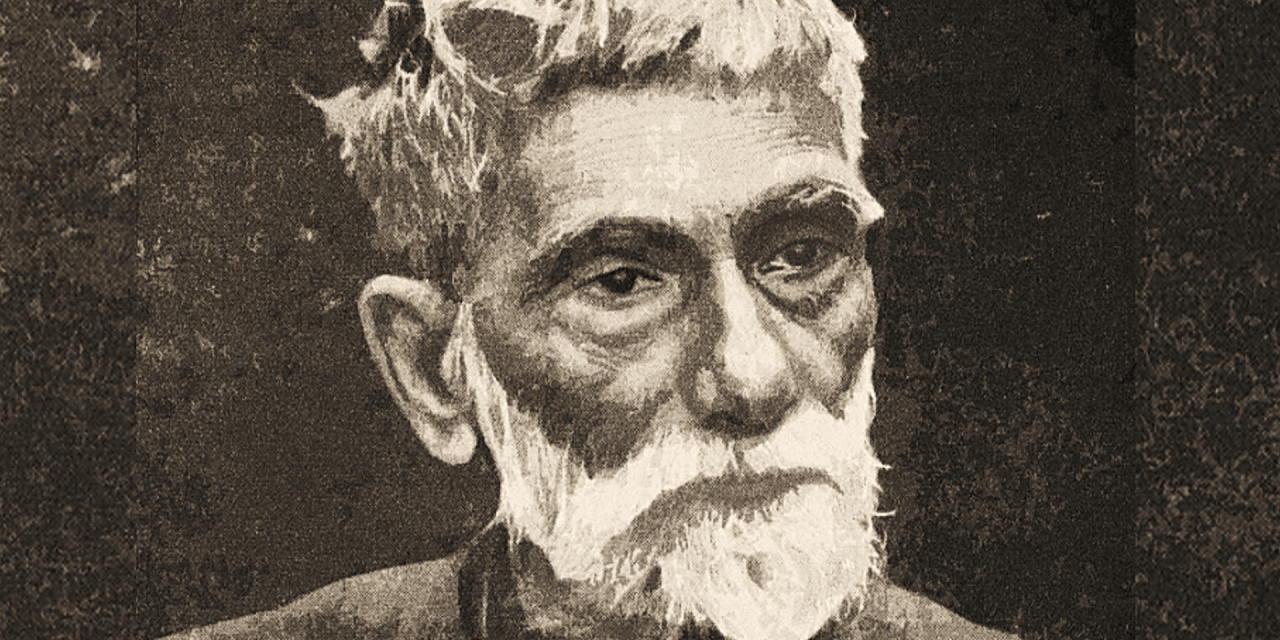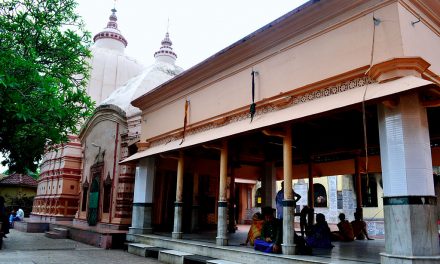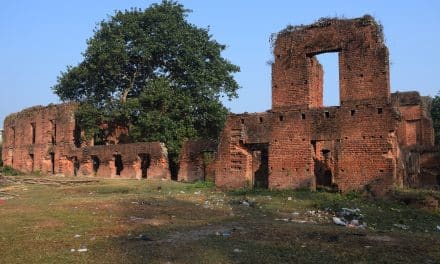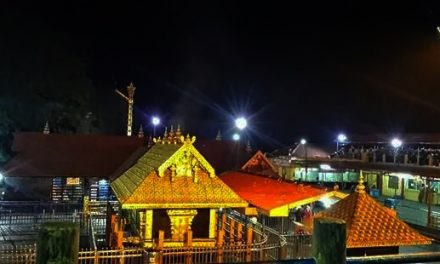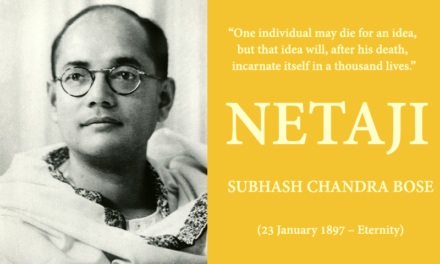Acharya Prafulla Chandra Ray is a luminary of unmatched stature in modern Indian science. In India, Acharya Ray is known as the “Father of Chemistry.” His works in inorganic chemistry in an age when organic chemistry was all the rage are seminal and pathbreaking. He announced the momentous discovery of mercurous nitrite, a result which he published in Journal of the Chemical Society of London in 1897. Henry Armstrong, after whom the fluorescent organic compound Naphthalene-1,5-disulfonic acid or Armstrong’s acid is named, spoke glowingly of this, saying
“The way in which you have gradually made yourself “master of nitrites” is very interesting and the fact that you have established that as a class they are far from being the unstable bodies, chemists had supposed, is an important addition to our knowledge.”
Every journal of repute from The Chemist and Druggist to Nature reported the discovery, and also caused him to become the first Indian of that era to be nominated for Fellow of Royal Society, in 16 December 1912, by William A. Tilden, Herold Baily Dixon, Henry E. Roscoe, Victor H. Veley, Alexander Crum Brown, Martin O. Forster, James Walker, Arthur W. Crossley, William Henry Perkin, Hugo Müller, Thomas H. Holland, James E. Reynolds, Herbert B. Baker, Percy F. Frankland, Alexander Pedler, William J. Pope and Alexander Scott. Some of the attainments of Acharya Ray mentioned in the nomination include ‘Mercurous Nitrite and its Derivatives … Isomorphism of Univalent Mercury with Silver … Decomposition of Hyponitrous Acid … Sublimation of Ammonium Nitrite in a Vacuum and Determination of the Vapour Density of the Ammonium Nitrite’. Being a vocal critic of British imperialism and a Gandhian, it is anyone’s guess why the nomination was not successful. In fact, Acharya Ray organised Gandhi’s first political meeting in Kolkata in 1901, after which the latter publically expressed his admiration for the young 32-year-old chemist. Later in life, Acharya Ray, in support of Gandhian philosophy, wore clothes made only out of Khadi.
The manner in which his most groundbreaking work came to be is a fascinating tale in itself. Acharya Ray’s discovery of mercurous nitrite turned up as ‘yellow needles resembling prismatic sulfur’ while he was in fact trying the preparation of another compound using nitric acid and mercury as part of routine lab work during those days. He subsequently described a method for preparing the elusive compound and also gave an exposition and analysis of he was able to identify it. Acharya Ray kept investigating the traits of mercurous nitrite over the next few years, also expanding the studies into that of ammonium and alkylammonium nitrites. Broadly, it got established that as a class nitrites have far more stability than chemists had supposed till then. The discovery remained controversial, however, due to the apparent inability to replicate the compound. Moreover, its structure remained a mystery, until recently when its structure was determined using X-ray crystallography.
Today, he has a Chemical Landmark Plaque from the Royal Society of Chemistry. He also mentored a number of luminaries, including Meghnad Saha and Nil Ratan Dhar. But what is fascinating about Acharya Ray is as much his multifaceted side as his concern for his nation, both its state during his times as well as its rich heritage. When he wasn’t teaching or conducting research, Prafulla Chandra Ray would stroll give his favorite pupils a motivational speech or draw them into a debate about social concerns affecting India at the time, which was still under British rule. Ray’s career and public life were directly impacted by the tense political era he lived in, which could appear strange for a chemistry professor. After receiving a doctoral degree in chemistry from the University of Edinburgh in 1888, Ray sailed home. Important developments building up to India’s attainment of independence in 1947 were just beginning to transpire at this period. Ray kept thinking about how he could put his scientific knowledge for the greater good while his academic life at the Presidency College in Kolkata soared. In his two-part memoirs, `Life and Experiences of a Bengali Chemist’, Ray remarked that
“The history of the gigantic progress of industry achieved in Europe and America is a history of the triumph of researches in the laboratory”
Upon founding Bengal Chemical and Pharmaceutical Works Limited (BCPW), the country’s first drugmaker, in the latter part of the 19th century, he anticipated that it would set a good example for the youth of his home province.
“In Bengal the one thing needful was not so much the establishment of Technological Institutes as the initiative, the dash, the pluck, the resourcefulness in our youths that go to the making of a businessman or an entrepreneur or a captain of industry. The college-bred youth has been found to be a hopeless failure; there is no driving power in him; at best he can only shine as a tool or as an automaton.”
How relevant are those words even today! To vie with British shipments on pharmacy shelves, Ray’s company introduced a spate of proprietary medications, including Tonic Glycerophosphate, and Syrup of Hypophosphite of Lime. BCPW was founded in 1905 in reaction to the British state’s attempt to divide Bengal into two provinces, which was generally recognized as a polarizing governmental ordinance. Historians view BCPW as a significant instance of Swadeshi, which was launched in response to this British legislation. People swarmed the streets to decry the decision and stopped purchasing products made in Britain. The initiative, which promoted economic independence, inspired a whole generation of purveyors and business-persons to produce goods locally. Acharya Ray’s was a Swadeshi in action, in establishing an indigenous chemical and scientific tradition that could compete with the colonial regime of the time. Altogether, he published more than 150 scientific papers, with some of them in the Journal of the Asiatic Society of Bengal. Acharya Ray was the primary force behind instituting the Indian Chemical Society in 1924, besides initiating its journal as the Founder-President of the Society.
“When work is coupled with a keen sense of enjoyment it does not tell upon your health; the very idea of locally manufacturing pharmaceutical preparations, which hitherto had to be imported, acted like a tonic.”
He was quite interested in preparing and producing traditional Indic medicines such as Ayurvedic products, albeit with a sense of realise and rigorous scientific understanding of the efficacy of such products. He was quite outspoken when it came to those practices and products that were nothing better than products of blind belief but had little medicinal or physiological effect. The interest in traditional medicine was a byproduct of seeking to know how and when chemistry arose in the times of yore. This led to the formulation of the famous work of Acharya Ray – A History of Hindu Chemistry, for which he investigated original Pali and Sanskrit texts for looking at how alchemy and Rasāyana-Śāstra evolved in India’s ancient past, translating scientific nomenclature of ancient Indian texts into more contemporaneous vocabulary in the process. More fascinatingly, it addressed the ever-important question about why India’s early scientific progress got derailed. As per the formulation by Acharya Ray, entrenchment of casteism had a big role to play in this. He writes, unflinchingly,
“The very touch of a corpse, according to Manu, is enough to bring contamination to the sacred person of Brahmin. Thus we find that shortly after the time of Vagbhata, the handling of a lancet was discouraged and anatomy and surgery fell into disuse and became to all intents and purposes lost sciences to the Hindus. Her soil was rendered morally unfit for the birth of a Boyle, a Descartes or a Newton and her very name was all but expunged from the map of the scientific world.”
Interestingly, Acharya Ray finds in Sri Adi Shankaracharya’s promotion of the Advaita Vedantin idea of the natural world as being illusory as one of the reasons for Indians to lose their curiosity of the empirical. There seems to be some infusion of European thought and approach in Acharya Ray’s thinking here.
His work ‘The History of Hindu Chemistry’ is a fascinating read. It is a product of extensive investigations with the help of Sri Ram Pundit Navakant Kavibhushana. This entailed going over scores of insect-eaten manuscripts from Kashmir, Benares, Tanjore, Tibet, Kathmandu, Ulwar and Madras. He studied the works of Charaka, Susruta and various standard works of the Ayurvedic and Iatro-chemical periods, including chemistry in the Siddhayoga of Vrinda and in Chakrapani. The chemistry in the iatro-chemical period, such as in Rasaratna Samucchaya, particularly on alum, Vitriols, Calamine (particularly zinc extraction), saltpeter and the Hindu method of preparing Calomel, and the preparation known as Swarna Sindura or Makaradhwaja and the identification of metals by their colouration of flames (such as that of tin being ‘pigeon-coloured’) were some of the topics of exploration in the book. Acharya Ray says that the processes described in Rasaratna Samucchaya “is so highly scientific that it can be quoted almost verbatim in any treatise on modern Chemistry.” He gives the elaborate accounts of processes such as sublimation and distillation as well as the apparatus required thereof, ascribing a large part of this work to the ancient Indian chemist Nagarjuna. There are insightful scientific comments such as how mercury must be treated with triple distillation when adulterated with lead and tin. Retorting to Sir Humphry Davy’s assertion that the ancients did not know how to distinguish between sodium carbonate and potassium carbonate, Acharya Ray highlighted that this was known to practitioners of Ayurveda, pointing out how in the work of Sushruta sodium carbonate is called Sarjikakshara and potassium carbonate is called Yavakshara. He also distinguishes, based on textual evidence, between Mridukshara (mild alkali) and Tikshnakshara (caustic alkali). Sushruta is shown to have mentioned how one can render alkali caustic by addition of lime as well as how to preserve caustic alkali in iron vessels.
So extensive was his research that Acharya Ray had extracts from texts such as Rasanakshatra Malika, Rasahridaya, Rasaratnakara, Rasendra Chintamani, Kakachandishwari Tantra, Rasakalpa, Rasarajalakshmi, Rasendra Chudamani, Rasapradipa, Rasaprakasha Sudhakara, Rasaratnakara of Nityanatha, Swarnatantra, Dhaturatnamala and Dhatukriya in his discussions. Acharya Ray gave fascinating discussions on mandura, vaikranta, kamkushta, makshika, sasyaka, gairika, rasa karpura, kajjvali (black sulphide of mercury, whose manufacturing process is mentioned in great detail by Chakrapani) and parpati tamram. In his time, Acharya Ray exposited a rather fascinating gathering of alchemists and experts of human physiology from various ancient civilisations “somewhere in the Himalayas” around 1000 BCE, saying
“On reading the Caraka, one often feels as if it embodies the deliberations of an international congress of medical experts, held in the Himalayan regions to which distant Balkh (Bactriana) sent a representative of Kāmkhāyana.”
Acharya Ray shows how the ancient Indian scholars gave immense emphasis on experimentation, with the following quote from Dhundukanatha’s Rasendra Chintamani
“They are alone to be regarded as real teachers who can show by experiment what they teach. They are the deserving pupils, who, having learnt the experiments from their teachers can actually perform them. The rest, both the teachers and the pupils, are merely stage-actors.”
There is also a fascinating extrapolation to date ancient texts based on scientific understanding of the respective ages by Acharya Ray, by comparing the Atharvaveda and Charaka’s treatise. While the former talks of plants and vegetable products, the latter contains alchemical formulas that use lead and gold. As a result, Acharya Ray concludes that the Atharvaveda was atleast a millennium older than the treatise of Charaka, bringing the composition of the Atharvaveda to 1500 BCE given Charaka’s life in the third century BCE. The book demonstrates unequivocally that ancient Hindus achieved significant advancements in surgery, alchemy, and the medical sciences, and that the rest of the world absorbed their scientific knowledge. To drive home this point, Acharya Ray mentions in the preface to the second volume published in 1907:
“ancient Hindu astronomy and mathematics were not less advanced than those of Tycho Brahe, Cardan and Fermat; the anatomy was equal to that of Vesalius, the Hindu logic and methodology more advanced than that of Ramus, and equal on the whole to Bacon’s; the physico-chemical theories as to combustion, heat, chemical affinity, clearer, more rational, and more original than those of Van Helmont or Stahl; and the Grammar, whether of Sanskrit or Prākrit, the most scientific and comprehensive in the world before Bopp, Rask and Grimm.”
The work established on firmer grounds the discourse on and for Hindu and Indic Science. He speaks on how the the knowledge of the East, particularly India, infused the workings and thought-process in the West:
“In the European histories of chemistry, the credit of being the first to press chemical knowledge into the service of medicine and introduce the use of the internal administration of mercurial preparations, is given to Paracelsus… The Nāgarjunas and Patānjalis of India, however, had the merit of anticipating Paracelsus and his followers by several centuries… We have indeed reasons to suspect that Paracelsus got his ideas from the East, and in Chapter on Arabian indebtedness to India we have pointed out the media through which Indian sciences filtered into Europe”
Closer home, and following on the comparative and inductive logic seen previously, he spoke of the transition to the second glorious period of Indic chemistry in the times of yore
“The necessary consequence of this great success was the separation of the pursuits of the physician from those of the priest”
In this way, Acharya Ray highlighted how the transition from period of the Atharvaveda to that of Ayurveda is marked by a division of labour separating the hieratic from the curative pursuits. Acharya Ray discussed the progress made by Indians in metallurgy in ancient times. The art of making and tempering steel were first discovered in India, with the Damascus blades being made of Indian steel. The iron girders of Puri, the iron pillar in Mehrauli in Delhi, the ornamental gates of Somnath and the iron-gun of Narwar show the excellence of the Hindus in metallurgical pursuits. The work History of Hindu Chemistry described as ‘pulsating with vitality and intellectual force’ by H. E. Armstrong in his review of the work in Nature in 1933.
Acharya Ray was a scientist-par-excellence but he was also the luminary who unearthed a long-forgotten tradition of Indian chemistry and science, which was built on rigorous empirical investigations. He was a chronicler of an age that saw the highest scholastic attainments by a people subsequently afflicted by centuries of socio-cultural and political degradation. Not being among one who glorifies his own people in vain, his critical pursuit of uncovering the true heritage of the Hindu and Indic people saw him bring the Indic civilisation back from behind the veil of obscurity to a rather scientific, even utilitarian, understanding. Reminding those in attendance of the place of honour assigned to India by the illustrious French chemist Jean Baptiste André Dumas, Acharya Ray famously concluded his January 1916 lecture in the Calcultta University with the words:
“I hope it will be hers once more to hold aloft the torch of Science and assert her true place in the comity of nations.”
That is the quintessence of the musings of the luminary known as Acharya Prafulla Chandra Ray.

